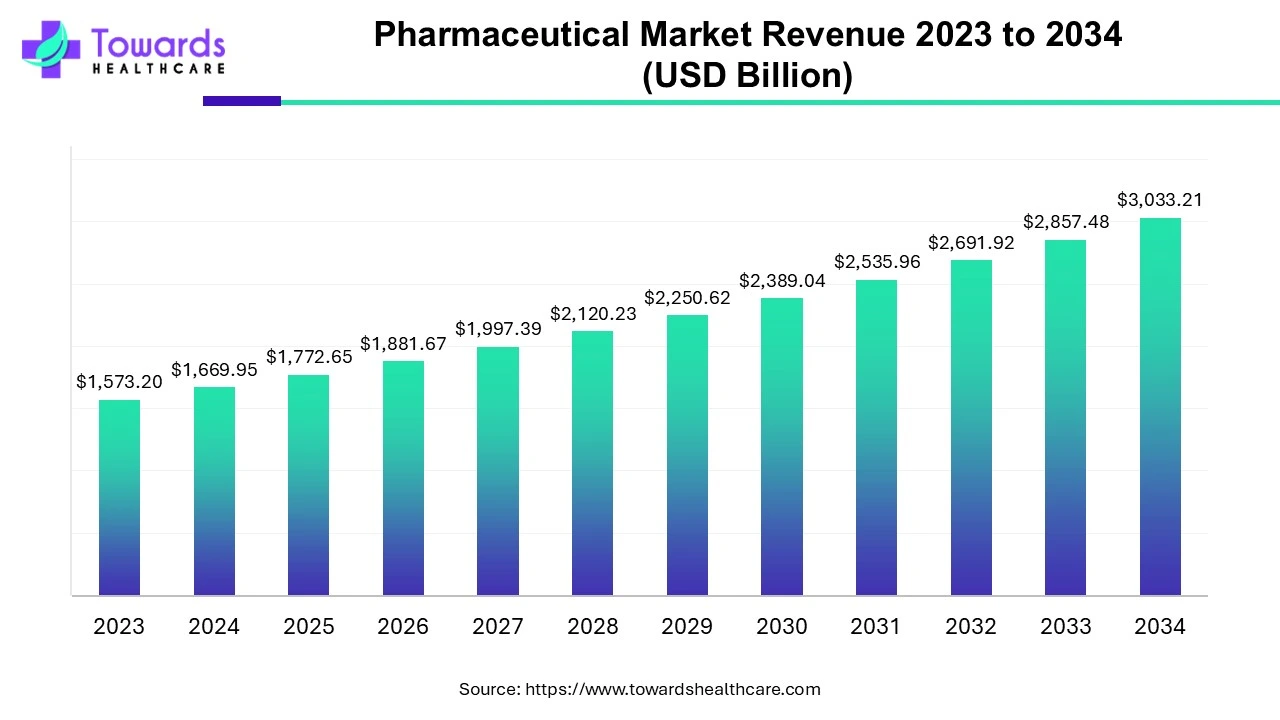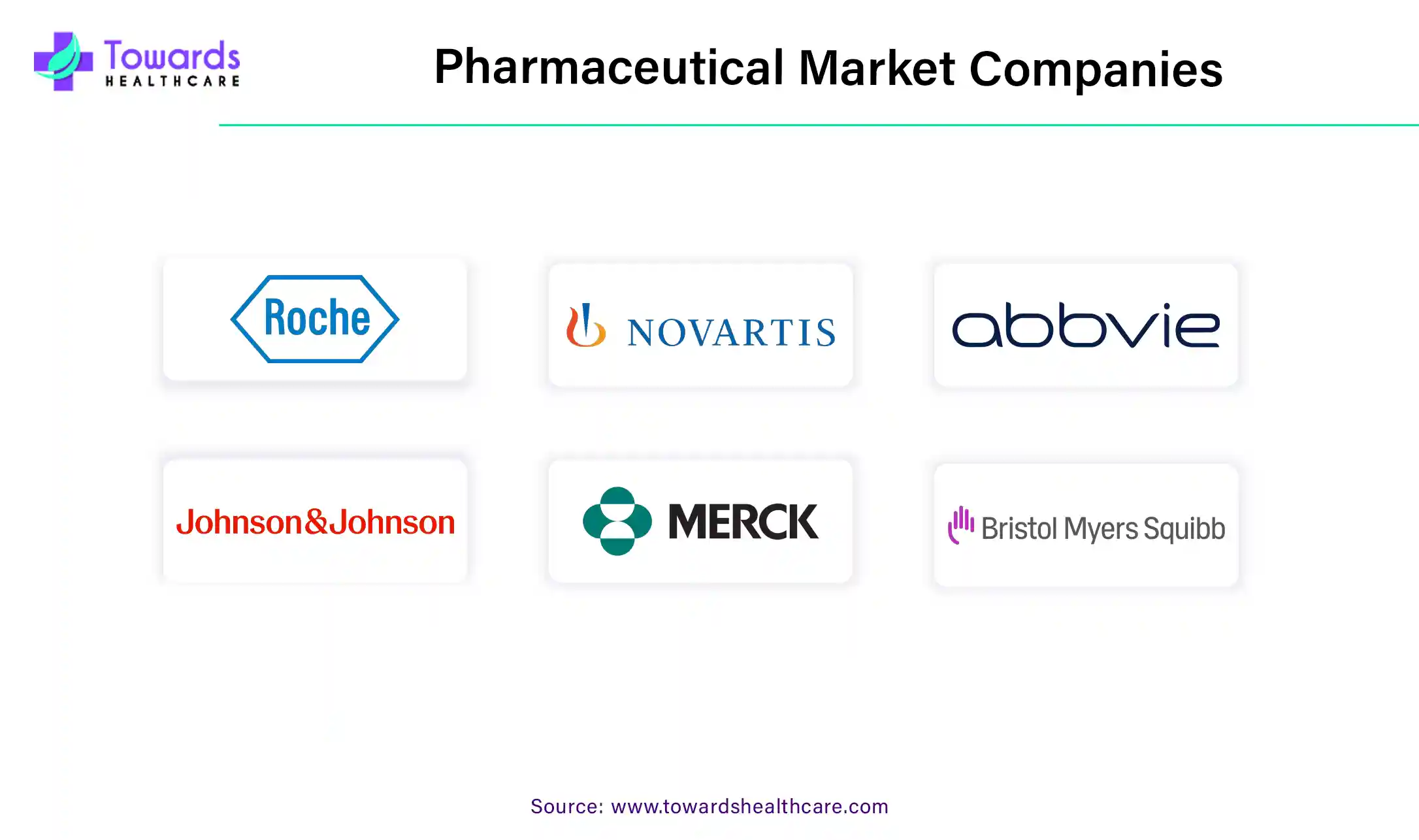March 2025


Principal Consultant

Reviewed By
The global pharmaceutical market size was estimated at US$ 1,573.20 billion in 2023 and is projected to grow to US$ 3,033.21 billion by 2034, rising at a compound annual growth rate (CAGR) of 6.15% from 2024 to 2034. The pharmaceutical industry is growing strongly due to the growing geriatric population, which requires continuous healthcare due to age-related health issues.

Businesses that find, develop, produce, distribute, and sell pharmaceutical goods are referred to as pharmaceutical industries. One of the most tightly regulated industries, the pharmaceutical industry has consistently produced high-quality pharmaceutical goods for human use that have the intended pharmacotherapeutic effects for the treatment of a wide range of illnesses. As one of the most R&D-intensive businesses (15%–20% of US revenues go toward R&D operations), the pharmaceutical sector is renowned for its competitiveness, high employment, both directly and indirectly, innovation, and its rapidly expanding biologics and generics section.
With over 3,500 medications now in development, precision medicine will continue to be a major area of focus for pharmaceutical innovation. The field's future is hinted at by Germany's ambitious ambition to use whole-genome sequencing in regular healthcare, the emergence of mRNA vaccines, and next-generation treatments that use CRISPR technology.
There are many parties involved in the manufacturing, distribution, and shipping of pharmaceuticals, making the supply chain complicated and heavily regulated. Although it might be difficult, it is crucial to guarantee the quality and safety of pharmaceutical goods at every point in the supply chain.
North America dominated the pharmaceutical market in 2023.
There are several reasons for this region's supremacy, including improvements in clinical trials and medication production in the US and Canada. Key companies are being prompted by these variables to create novel goods in the area, which is propelling market expansion. The region's growing number of medicinal approvals is another important element supporting the market's expansion.
The scale of the pharmaceutical industry in the United States is enormous.29 The markets in developing countries are comparatively more diverse, with groups with higher purchasing power investing more in innovation and those with lower purchasing power investing more in generics. With high healthcare spending per capita, aging populations, and sophisticated regulatory frameworks, industrialized nations in North America remain the top markets for pharmaceutical goods.
Asia Pacific is expected to grow at the fastest rate during the forecast period.
Demand for innovative items rises as people become more conscious of the treatment and management of illnesses. Furthermore, it is projected that the region's need for and accessibility to treatment choices would increase as a result of growing domestic firms' investments there and mergers with important players.
The pharmaceutical sector in India is a major player in the worldwide pharmaceutical market. India sells pharmaceuticals to more than 200 nations, making it a major exporter. About 40% of the US's generic needs, more than 50% of Africa's generic needs, and about 25% of the UK's total drug supply come from India. India is also a major provider of DPT, BCG, and measles vaccinations, and it supplies around 60% of the world's vaccine orders. India supplies 70% of the vaccines used by the WHO (according to the essential immunization schedule).
For instance,
By molecule type, the conventional drugs segment held the largest share of the pharmaceutical market in 2023. The nauseating powers are frequently destroyed, demolished, or suppressed by conventional medicine. Conventional medicine is characterized as a type of medicine that seeks to repress the causes of sickness, considers health as the absence of disease, diagnoses particular organ or tissue aberrations, and usually requires passive patient engagement in therapy.
By product, the branded segment held the dominant share of the market in 2023. Branded medications are the original goods that pharmaceutical companies create and sell. They must be approved by the Food and Drug Administration (FDA) and go through rigorous clinical testing. To recoup their high development expenses, pharmaceutical corporations usually keep a patent for 20 years.
By product, the generic segment is estimated to grow at the fastest rate during the forecast period. As consumers and payers look for methods to reduce healthcare expenses, the demand for generic medications is still rising globally. Under typical market settings, rising healthcare expenses would result in higher generic medicine prices due to the growing demand for these medications.
By type, the prescription segment held the major share of the pharmaceutical market in 2023. Generally speaking, prescription drugs are more effective than over-the-counter remedies. For this reason, medications need to be taken under a doctor's supervision to ensure their safe use.
By type, the OTC segment is anticipated to grow at the fastest CAGR during the predicted timeframe. Because OTC medications have low toxicity, the FDA has concluded that the advantages of using them exceed any potential risks or adverse effects. For self-diagnosed diseases, these drugs are similarly simple to use. They are well-labeled with usage instructions, cautions, and directions. Compared to prescription drugs, they are frequently less effective.
By disease, the cancer segment dominated the pharmaceutical market in 2023. The market for pharmaceutical oncology is changing significantly despite the anticipated increase. Pharma firms involved in cancer are currently competing to use new digital platforms and data sources to better interact with patients, providers, and regulators.
By route of administration, the oral segment secured the largest share of the market in 2023. The most popular method of medication delivery is oral since it is non-invasive, highly patient-complied with, economical, easy to use, and doesn't require any special sterile conditions.
By route of administration, the parenteral segment is estimated to grow at the fastest rate in the pharmaceutical market in 2023. Parenterally given medications have a quicker beginning of effect since they are absorbed more quickly than when taken orally. They have a stronger impact than oral drugs because they are digested differently and do not go through the digestive processes in the gastrointestinal tract.
By formulation, the tablets segment was dominant in the market in 2023. Benefits include stability, ease of packaging, shipping, and dispensing, as well as ease and economy in preparation. Patients value tablets for their convenience of use, compact size, and precise dosing.
By formulation, the sprays segment is expected to grow at the fastest rate during the forecast period. Pharmaceutical sprays are medications that are breathed in orally or through the nose. Sprays use atomization to transform a liquid or solid composition into a dynamic combination spread across a gas.
By age group, the adults segment dominated the pharmaceutical market in 2023. This group is the largest and consumes various pharmaceutical products for better health and to improve quality of life.
By age group, the children & adolescent segment is estimated to witness strong growth during the forecast period. This group is prone to health issues due to weak immunity and hormonal changes.
By end-user, the hospitals segment held the dominant share of the pharmaceutical market in 2023. A large population visits hospitals for disease treatment, during which a lot of pharmaceuticals are used in the hospital.
By end-user, the clinics segment is expected to grow at the fastest growth rate during 2024-2034. For basic medication, people often visit clinics. Apart from this, specialty clinics are visited by patients for specialized treatment.

Healthcare leaders gathered at Health Evolution's 2023 Connect to discuss important topics pertaining to the sector, including the pharmaceutical market's critical obstacles. Leaders urged CEOs to use new AI technologies, pointing out that recent developments in AI might significantly affect pharmaceutical research and innovation. In general, leaders stressed the need for creative leadership to adopt new pharmaceutical advances and develop mechanisms that would guarantee the accessibility and affordability of upcoming therapies.
By Molecule Type
By Product
By Type
By Disease
By Route of Administration
By Formulation
By Age Group
By End-user
By Region
March 2025
March 2025
January 2025
January 2025